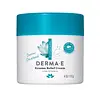What's inside
What's inside
 Key Ingredients
Key Ingredients

 Benefits
Benefits

 Concerns
Concerns

 Ingredients Side-by-side
Ingredients Side-by-side

Colloidal Oatmeal 1%
AbsorbentAllantoin
Skin ConditioningArctium Lappa Root Extract
Skin ConditioningArctostaphylos Uva-Ursi Leaf Extract
Skin ConditioningCaprylic/Capric Triglyceride
MaskingCetearyl Glucoside
EmulsifyingCetyl Alcohol
EmollientChamomilla Recutita Flower
Skin ConditioningCoco-Caprylate
EmollientCoptis Chinensis Root Extract
AntioxidantDimethicone
EmollientEthylhexylglycerin
Skin ConditioningFagara Zanthoxyloides Fruit Extract
Skin ConditioningGlycerin
HumectantGlyceryl Stearate
EmollientGlyceryl Stearate Citrate
EmollientLeuconostoc/Radish Root Ferment Filtrate
AntimicrobialMelia Azadirachta Leaf
Skin ConditioningPhenoxyethanol
PreservativePotassium Sorbate
PreservativeWater
Skin ConditioningSimmondsia Chinensis Seed Oil
EmollientSodium Hydroxide
BufferingStearic Acid
CleansingStearyl Alcohol
EmollientTocopheryl Acetate
AntioxidantColloidal Oatmeal 1%, Allantoin, Arctium Lappa Root Extract, Arctostaphylos Uva-Ursi Leaf Extract, Caprylic/Capric Triglyceride, Cetearyl Glucoside, Cetyl Alcohol, Chamomilla Recutita Flower, Coco-Caprylate, Coptis Chinensis Root Extract, Dimethicone, Ethylhexylglycerin, Fagara Zanthoxyloides Fruit Extract, Glycerin, Glyceryl Stearate, Glyceryl Stearate Citrate, Leuconostoc/Radish Root Ferment Filtrate, Melia Azadirachta Leaf, Phenoxyethanol, Potassium Sorbate, Water, Simmondsia Chinensis Seed Oil, Sodium Hydroxide, Stearic Acid, Stearyl Alcohol, Tocopheryl Acetate
Colloidal Oatmeal 1%
AbsorbentWater
Skin ConditioningSqualane
EmollientCaprylic/Capric Triglyceride
MaskingGlycerin
HumectantHydrogenated Sunflower Seed Oil Polyglyceryl-3 Esters
EmulsifyingHydroxystearic/Linolenic/Oleic Polyglycerides
EmollientButyrospermum Parkii Butter
Skin ConditioningJojoba Esters
EmollientCeramide NP
Skin ConditioningTocopherol
AntioxidantSodium Phytate
Hydrogenated Sunflower Seed Oil Glyceryl Esters
EmulsifyingCetearyl Alcohol
EmollientPropanediol
SolventHydroxyacetophenone
AntioxidantSodium Stearoyl Lactylate
EmulsifyingXanthan Gum
EmulsifyingEthylhexylglycerin
Skin ConditioningPotassium Sorbate
PreservativeCitric Acid
BufferingColloidal Oatmeal 1%, Water, Squalane, Caprylic/Capric Triglyceride, Glycerin, Hydrogenated Sunflower Seed Oil Polyglyceryl-3 Esters, Hydroxystearic/Linolenic/Oleic Polyglycerides, Butyrospermum Parkii Butter, Jojoba Esters, Ceramide NP, Tocopherol, Sodium Phytate, Hydrogenated Sunflower Seed Oil Glyceryl Esters, Cetearyl Alcohol, Propanediol, Hydroxyacetophenone, Sodium Stearoyl Lactylate, Xanthan Gum, Ethylhexylglycerin, Potassium Sorbate, Citric Acid
Ingredients Explained
These ingredients are found in both products.
Ingredients higher up in an ingredient list are typically present in a larger amount.
This ingredient is an emollient, solvent, and texture enhancer. It is considered a skin-softener by helping the skin prevent moisture loss.
It helps thicken a product's formula and makes it easier to spread by dissolving clumping compounds.
Caprylic Triglyceride is made by combining glycerin with coconut oil, forming a clear liquid.
While there is an assumption Caprylic Triglyceride can clog pores due to it being derived from coconut oil, there is no research supporting this.
Learn more about Caprylic/Capric TriglycerideAccording to INCI standards, this ingredient refers to the physical ground up oatmeal. If you are looking for colloidal oatmeal in skincare, you'll most likely see Avena Sativa Kernel Extract on your ingredient list.
Physical colloidal oatmeal is an abrasive meaning it provides physical exfoliation.
Ethylhexylglycerin (we can't pronounce this either) is commonly used as a preservative and skin softener. It is derived from glyceryl.
You might see Ethylhexylglycerin often paired with other preservatives such as phenoxyethanol. Ethylhexylglycerin has been found to increase the effectiveness of these other preservatives.
Glycerin is already naturally found in your skin. It helps moisturize and protect your skin.
A study from 2016 found glycerin to be more effective as a humectant than AHAs and hyaluronic acid.
As a humectant, it helps the skin stay hydrated by pulling moisture to your skin. The low molecular weight of glycerin allows it to pull moisture into the deeper layers of your skin.
Hydrated skin improves your skin barrier; Your skin barrier helps protect against irritants and bacteria.
Glycerin has also been found to have antimicrobial and antiviral properties. Due to these properties, glycerin is often used in wound and burn treatments.
In cosmetics, glycerin is usually derived from plants such as soybean or palm. However, it can also be sourced from animals, such as tallow or animal fat.
This ingredient is organic, colorless, odorless, and non-toxic.
Glycerin is the name for this ingredient in American English. British English uses Glycerol/Glycerine.
Learn more about GlycerinPotassium Sorbate is a preservative used to prevent yeast and mold in products. It is commonly found in both cosmetic and food products.
This ingredient comes from potassium salt derived from sorbic acid. Sorbic acid is a natural antibiotic and effective against fungus.
Both potassium sorbate and sorbic acid can be found in baked goods, cheeses, dried meats, dried fruit, ice cream, pickles, wine, yogurt, and more.
You'll often find this ingredient used with other preservatives.
Learn more about Potassium SorbateWater. It's the most common cosmetic ingredient of all. You'll usually see it at the top of ingredient lists, meaning that it makes up the largest part of the product.
So why is it so popular? Water most often acts as a solvent - this means that it helps dissolve other ingredients into the formulation.
You'll also recognize water as that liquid we all need to stay alive. If you see this, drink a glass of water. Stay hydrated!
Learn more about Water